“Can we still recycle plastics?”
“What do the numbers mean?” “Styrofoam is marked, doesn’t that make it recyclable?”
In the early 20th century, there were only a handful of plastics and very few uses for it. Fast forward 100 years and it’s hard to find things that we don’t use plastic for. These days you can find plastic in buildings, homes, clothing – almost anywhere! Despite the many uses for plastic, technology and nature struggle to keep up with the amount of plastic waste we produce. A lot of the plastic items we use are meant to be low-cost and disposable which creates an awful lot of plastic trash.
Reduce, Reuse and Recycle Your Plastics Responsibly
What can we all do to reduce and limit all our plastic waste? Reduce, reuse and recycle of course! In this blog post, we will simplify what types of plastic we can recycle in the Blue Bin and beyond. At the end of this blog post, check out our “Guide for Recycling Plastic” flow chart. It will help you determine how to best dispose of your plastic items, bags and wraps.
There are many benefits of recycling plastic! When compared to producing new plastic products, recycled plastic products require up to 88% less energy to manufacture. This is because much of the energy used during the manufacturing process is used to create brand new plastic from raw materials such as petroleum or natural gas. Recycling plastic saves energy, provides jobs, reduces waste sent to landfills and helps prevent litter from entering the ocean. Recycled plastic can be used in a variety of ways from fabrics to insulation.
In order to see the benefits of recycled plastic, we have to avoid and prevent contamination at the Materials Recovery Facility. Contamination occurs when the wrong products are placed in the Blue Bin and end up getting sorted with different materials. To learn more about contamination, read our blog post: No Contamination November. It is extremely important that products are sorted into bales with only the same materials. This allows the bales to be sold and turned into new products easily. With so many different types of plastics and plastic products, it can be a little confusing or difficult to know what to do or how to recycle them.
Don’t worry, though! Saint Louis City Recycles is here to help residents understand what we can and cannot recycle in our Blue Bins. 🤗 This post will walk you through the many types of plastic products, how we should properly dispose of them and concludes with an easy to follow flowchart to help you recycle plastics responsibly!
Recycling Simplified
Have you noticed the numbers inside the recycling symbol ♻ on plastic products? 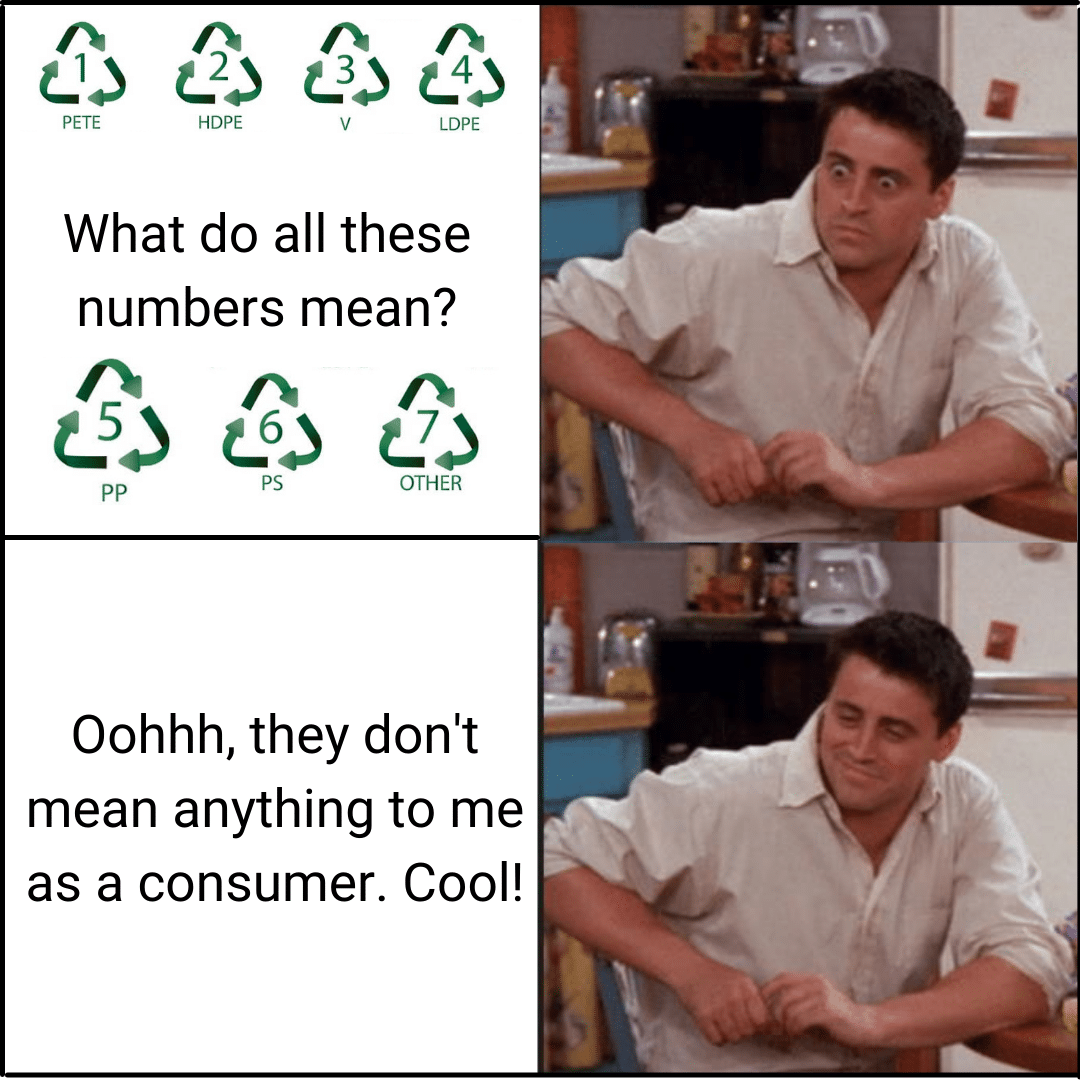 Forget about the numbers. That’s right! The numbers don’t mean anything to you as the consumer. The 1 through 7 numbering system is called a resin identification code. It was developed in the late 1980s as a way to help recyclers, not consumers, identify the type of resin a plastic is made from. The numbers only mark what type of plastic the object is made of, not whether it is recyclable.
Forget about the numbers. That’s right! The numbers don’t mean anything to you as the consumer. The 1 through 7 numbering system is called a resin identification code. It was developed in the late 1980s as a way to help recyclers, not consumers, identify the type of resin a plastic is made from. The numbers only mark what type of plastic the object is made of, not whether it is recyclable.
Our recyclables are collected, transported and sorted at a Materials Recovery Facility (MRF). For plastics, our MRF can only process empty plastic bottles and containers.
If you’re wondering whether a plastic item is recyclable, ask this question: is it a bottle or container that’s in the accepted size range? The flowchart at the end of this blog post will make it easy for you to determine whether an item should be recycled in your Blue Bin, recycled elsewhere beyond the Blue Bin or be placed in the trash.
Size and Shape Matter
When it comes to recycling plastics, size and shape also matter. 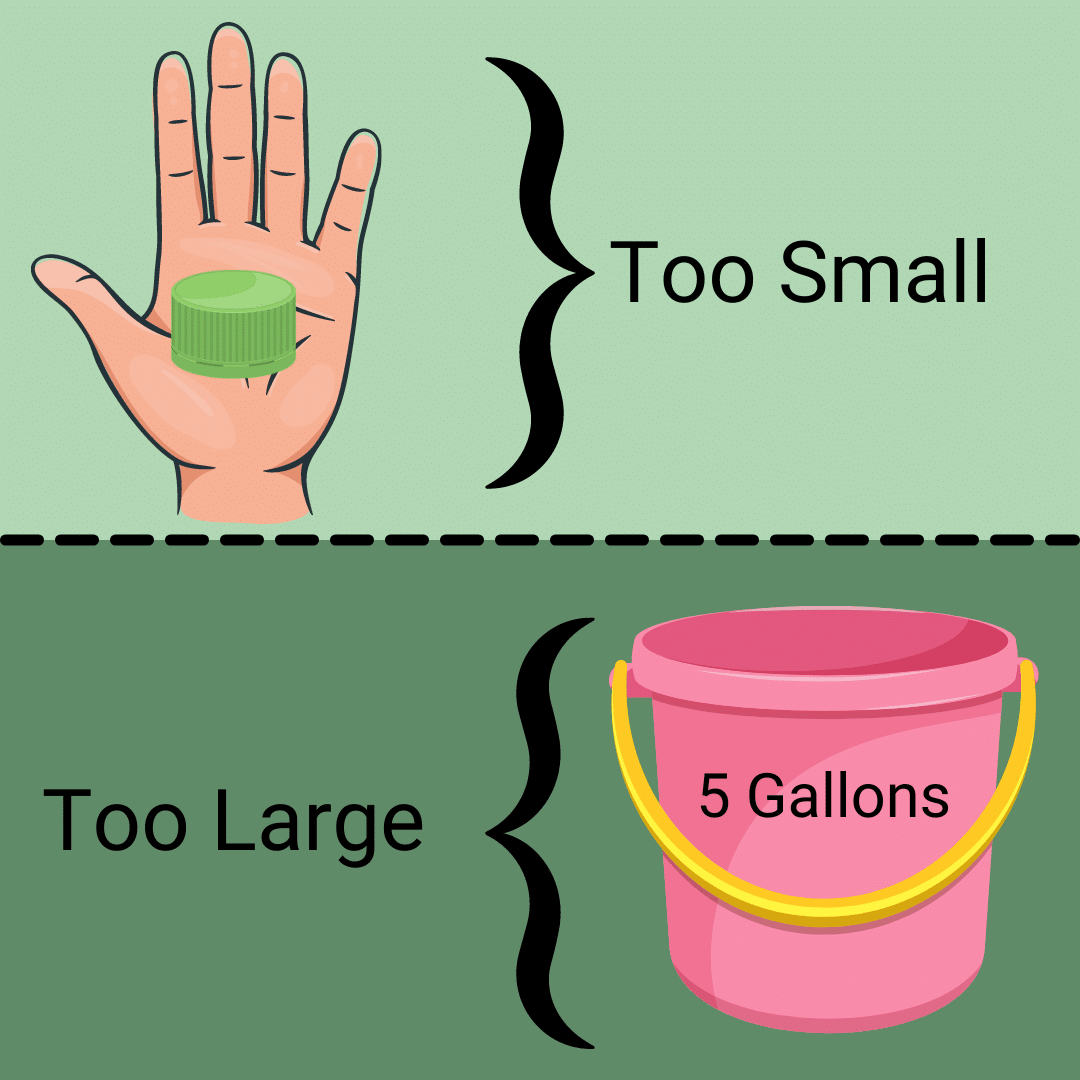 Plastics smaller than three inches in both height and diameter are too small to be processed. An easy way to see if an item is too small is to compare it to the palm of your hand. If it is smaller than the palm of your hand then it is too small to go into your Blue Bin.
Plastics smaller than three inches in both height and diameter are too small to be processed. An easy way to see if an item is too small is to compare it to the palm of your hand. If it is smaller than the palm of your hand then it is too small to go into your Blue Bin.
When very small items make it to the MRF, and get sorted, they end up contaminating other recyclable materials. 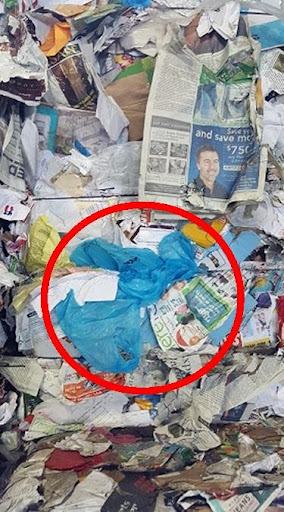 This is similar to how plastic bags can end up sorted with paper (pictured on the left) They could also harm the recycling equipment by getting jammed in sorting gears or conveyor belts over time.
This is similar to how plastic bags can end up sorted with paper (pictured on the left) They could also harm the recycling equipment by getting jammed in sorting gears or conveyor belts over time.
Lids and caps are small items that should always be reattached to their container so they can be recycled. This way they get a “ride” through the sorting facility and end up with like materials.
Items larger than five gallons are considered oversized for the MRF and won’t fit through the machinery. They will damage sorting equipment and put workers at risk. This doesn’t mean you have to throw these items away, though! You can donate items like intact plastic toys or laundry baskets to second-hand stores or charities. Even if it’s not reusable to you, it might be to someone else!
To find places to donate large items or specialty places that upcycle undersized items like bottle caps or wine works, check out our database: STLCityRecycles.com/database
Let’s talk about shape now! You can recycle empty plastic bottles and containers in your Blue Bin! The recycling sorting facility was developed to process these types of plastic items. Wondering what we mean by plastic bottles? The image below has some clear identifying traits of plastic bottles. Some examples of bottles include: plastic water bottle, lotion bottle, contact solution bottle, laundry detergent and personal care products such as shampoo and soap. Once they are empty and dry, replace any caps or lids and then recycle these plastic bottles in your Blue Bin!
Containers are made from a kind of plastic that manufacturers can easily recycle and sell for making products such as carpet, fleece clothing or even more plastic bottles. The image below offers some clear characteristics and examples of plastic containers that you can recycle in your Blue Bin.
Recycled plastic bottles and containers can be upcycled into a variety of new products. Some of these include: carpet, upcycled polyester for clothing, recycled plastic building materials for outdoor furniture, decking, playground equipment, new plastic bottles, containers for beauty products, and durable plastics such as plant holders.
Definite No’s
Many products are packaged in plastic like the ones pictured on the left. 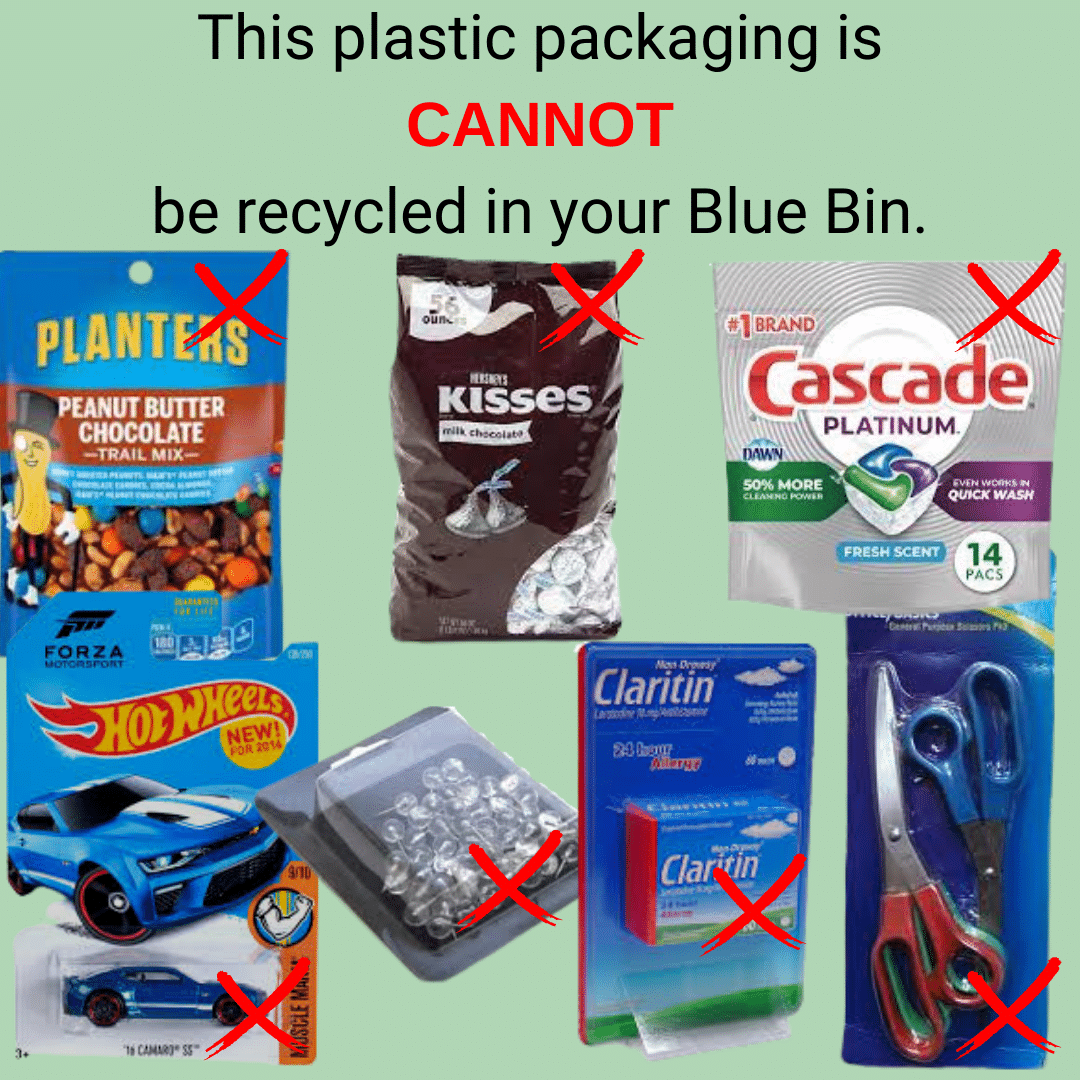 They could contain flimsy plastic, a different type of plastic or aluminum lining on the inside or flexible plastic coverings attached to cardboard. Some items come packaged in plastic pouches like what you would find dishwasher tabs or trail mix in.
They could contain flimsy plastic, a different type of plastic or aluminum lining on the inside or flexible plastic coverings attached to cardboard. Some items come packaged in plastic pouches like what you would find dishwasher tabs or trail mix in.
Most Materials Recovery Facilities, including ours, cannot recycle items made of multiple types of materials like an oatmeal container, for example. Or, the shape is incorrect for sorting because it’s not a plastic bottle or container. For example, a plastic pouch that once held trail mix cannot hold its shape and becomes flat like paper. At the MRF, the machinery will sort it like paper contaminating that bale. Keep these items out of your Blue Bin as they are not recyclable!
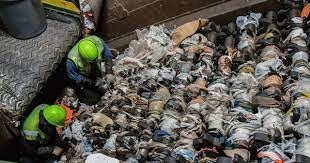
- NEVER put plastic bags or wrap in your Blue Bin! Plastic bags and wrap clog up the machinery and can cost the MRF up to 5 hours a day in labor to manually cut plastics out of the gears. Plastic bags and wrap that make their way through the sorting process will end up as contamination inside the bales of recyclable materials.
- Bales that are visibly contaminated have a high likelihood of being rejected by the material buyer and landfilled. Many local grocery or retail stores accept plastic bags for recycling in designated bins near their entrance. When using these, be sure to remove receipts or any other items from the bags.
- Check out this post for more on the impacts of plastic bags.
- Click here for more info on plastic film recycling.
- It’s also important to never bag up your recycling–workers will attempt to pull it off the sorting line and it will be sent to the landfill! 😔
- Finally, styrofoam is NOT recyclable in our Blue Bins, even though it’s a type of plastic. Styrofoam is not recyclable in your Blue Bin, regardless of whether it’s a container. Since it is made of mostly air, a special machine is required to remove the air and condense the material into a patty or block for resale. There is little to no after sale market for styrofoam because once the air is removed, very little material remains and they can’t be remade into other items easily. See our database for places that will accept shipping foam.
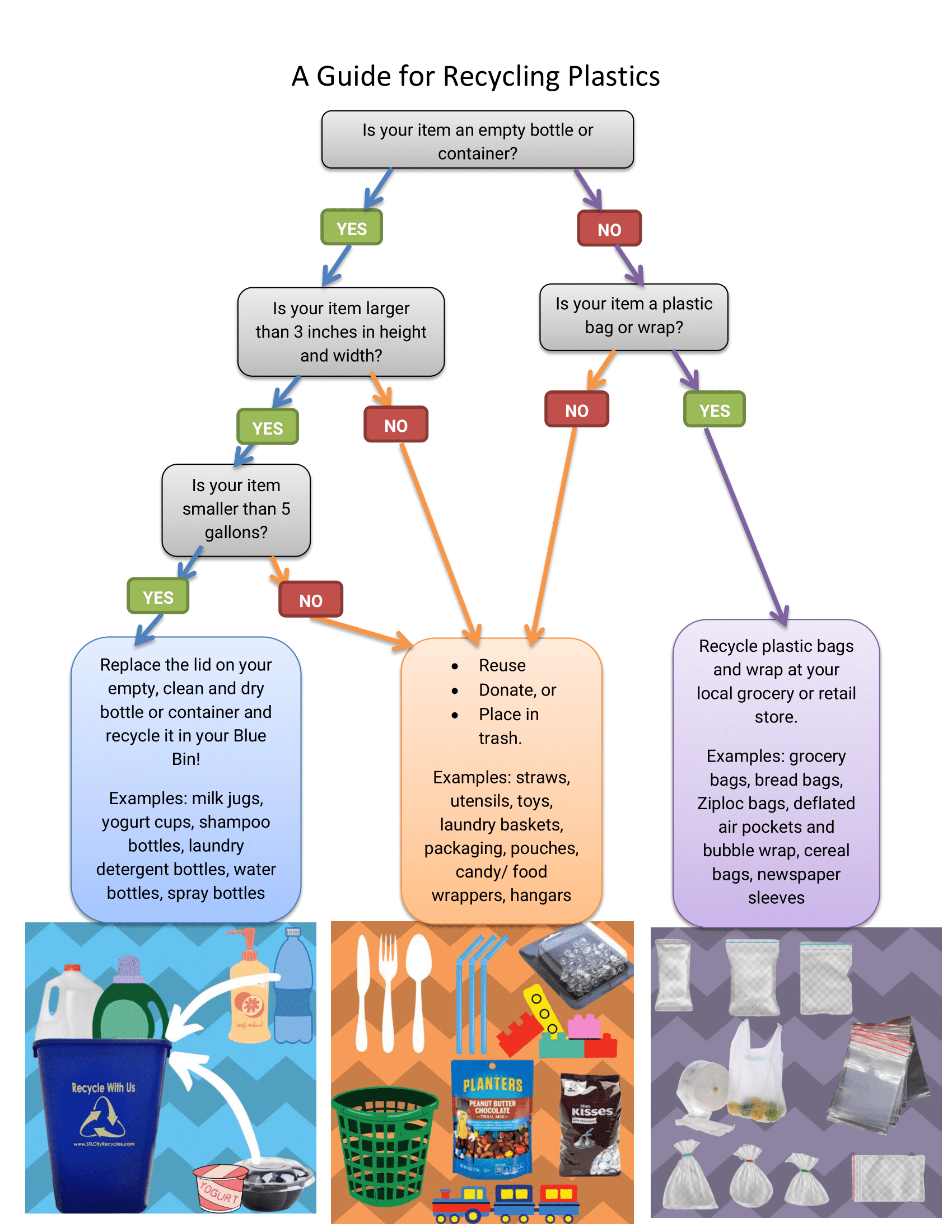
Additional Resources:
2018 EPA Recycling Facts and Figures
2018 EPA Trends in Materials Generation and Management in the United States
Recycle Across America General Recycling Information
Readers Digest: What happens to Recycled Plastic
Recycle Track Systems Plastic Recycling Facts







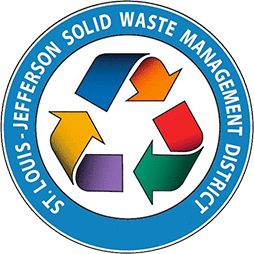



40 Comments
I have been putting plastic straws in plastic water bottles. will that help to recycle the plastic straws? and are vitamin bottles recyclable?
That’s very creative! Unfortunately, the plastic straw is made of a plastic that’s not recyclable to begin with so putting them inside a plastic container will just contaminate the recycling.
vitamin and pill bottles that are 3″ in diameter or larger are recyclable. Smaller bottles can be upcycled through places like Upcycle Treasure Box: http://www.stlteachertradingpost.com
I asked a couple of years ago if pill bottle were recyclable and was told yes. Has something changed or did I receive incorrect information at the time?
Yes, that is one thing that has changed with the switch to a new sorting facility. Regular pill bottles are too small to be properly sorted. Larger bottles, for vitamins and such, that are bigger than 3″ can still be recycled through your regular recycling. Smaller pill bottles can be sent to TerraCycle via Upcycle Treasure Box: https://www.stlteachertradingpost.com/St._Louis_Teacher_Trading_Post/Welcome.html
Is “type 6” plastic now recyclable? I thought I had read something suggesting that SOLO cups (usually made form the same material) were now recyclable.
If so, is other “type 6” plastic like this recyclable, like, say, the plastic trays that hold Girl Scout cookies?
Hello Dave,
It’s not that type 6 is recyclable, it’s that the numbers don’t tell you whether an item is recyclable. What is important is whether the plastic item is a bottle or a container. A plastic cookie tray is not recyclable, regardless of the number, because it is not a container (it’s a liner).
I’m trying to find out if the plastic pots and six packs that nursery plants come in are recyclable and can’t find anything. Spent over 10 minutes looking. Formerly, one could find a list of numbers for which plastics were recyclable. That made it simple. This container/not container definition is silly. It requires people to know how you define container but your definition is based on the manufacturing business, not on general understanding.
Good question! Plastic pots that are 5 gallons and smaller can be recycled in your Blue Bin. Plastic trays cannot, but many nurseries accept them back for recycling. You can find a current list in our recycling database (STLCityRecycles.com/database). A bottle or container holds is shape (not a plastic bag).
The Materials Recovery Facility accepts all plastic numbers #1-7, but not plastic bags or styrofoam. We don’t use numbers to say what is accepted, but rather what type of item is accepted. If we said numbers that are or aren’t accepted this could result in types of plastic being recycled we don’t want (plastic bags and styrofoam) or plastic not being recycled because we said we don’t accept certain numbers.
Is a laminated paperboard with a PET liner on one side recyclable? I was told this is recyclable in streams that accept laminated boards like coffee cups and ice cream tubs. Thank you.
Good question! No, these items (coffee cups and ice cream cartons) are not recyclable in your Blue Bin, but for different reasons. The freezer cartons have an extra preventative liner in them to prevent freezer burn. Paper/coffee cups have a liner to prevent leaking. However, cartons from the shelf or refrigerated sections (broth, orange juice, wine, snacks) are recyclable in your Blue Bin.
Is it possible to recycle the kind of plastic bags that potting soil comes in?
Plastic bags that contained potting soil cannot be put in your Blue Bin because it will jam the machinery that sorts recyclables. Only plastic bottles and containers can be recycled in your Blue Bin. For potting soil bags they should be completely empty (often turning the bag inside out helps) and then you can recycle this bag at the grocery store with your plastic bags and other plastic film. To find what other items are considered plastic film or find a nearby grocery or retail store that accepts plastic bags and film visit: PlasticFilmRecycling.org
Thanks for recycling responsibly!
Would a plastic cupcake/muffin container be considered recyclable? It’s listed as a 6, but I know that doesn’t always qualify if something is recyclable or not.
Good question! A plastic clamshell cupcake/muffin container can be recycled in your Blue Bin. Instead of figuring out what numbers are / aren’t recyclable, start with the question, is the item a bottle or container? If yes, recycle it! If not, throw it in the trash. The biggest plastic issues are plastic bags and film (such as bread bags, ziplock bags, mailers, etc.) and styrofoam. Never put these in your Blue Bin. Thanks for recycling responsibly!
Thank you for all these questions and responses !
Does MRF recycle (or compost) PLA lined take out containers?
Great question! The Materials Recovery Facility (MRF) only recycles items, it does not compost items. These compostable containers cannot go in our recycling bins. If you’d like to recycle them, they would need to be taken to a commercial compost facility or placed in the trash. Thanks for recycling responsibly!
Are reusable polypropylene shopping bags okay for the blue bin?
Hello! Unfortunately, no type of shopping bags are acceptable in the Blue Bin. These can be recycled at a textile location. You can find one near you here at STLCityRecycles.com/dropoff
What about Madela baby bottles; clean, of course. I understand that nipples, valves or anything silicone is not recyclable, but the bottles, lids, rings, and caps are all polypropylene (#5). As long as the smaller parts are attached to bottles (making them larger than 3 inches), are they all recyclable? Thank you for your time!
Great question! Yes, as long as the silicone parts are removed, the bottle (with attached parts) can be put in the Blue Bin! Thanks for recycling responsibly! 😀
I have a question about the plastic trays that some grocery stores use for packaging meat: they are sturdy, thick plastic that retain their shapes fairly well (so they do not crumple as easily as cookie tray liners). They do not have lids. Would they be recyclable?
That is a great question! Would you be able to send a photo of the item you are referring to? You can email the photo to recycle@stlouis-mo.gov and then we can let you know if they are recyclable in your Blue Bin or not. Thank you!
After some investigating, based off of your description, the plastic just needs to be cleaned with soap to prevent bacteria growth and remove any plastic film or liners, then it can be placed in your Blue Bin!
thanks for the 2022 plastic recycling update I truly want ro help save this planet
Our pleasure! Thank you for recycling responsibly!🤗
I’m wondering about the coated paper boxes that soap bars (ie, Dove bar soap) are sold in. I’m assuming that this type of paper cannot be recycled and should be discarded in trash?
Great question! You CAN recycle those boxes in your Blue Bin!🤗
How about plastic cups? Like red plastic Solo cups. Are those containers and therefore recyclable?
You can recycle red solo cups in the Blue Bin!
Can you recycle plastic beach balls?
Plastic blow up beach balls cannot go in the Blue Bin. You can use super glue or a patch to fix the ball and if you don’t want it anymore you can donate the fixed/ undamaged ball as I’m sure someone else would love to have it!
Can I recycle K-cups? I know there are a few components, so here’s what I’m thinking…
– grounds and filter – no, take out and compost / trash
– #5 plastic – yes, empty completely and rinse
– foil top – yes, separate, rinse, dry, crumple in ball and recycle
Is this correct? Thanks!
Excellent question! Unfortunately, K-cups are not recyclable in the Blue Bin because they are too small. The manufacturer could have a mail-in recycling program, you can find that out by looking up the company or looking at the packaging they come in. When recycling the foil, make sure the ball is at least the size of a golf ball. Alternatively, there are a lot of reusable k-cups you can order online to avoid the extra waste!
Are #5 plastic bottles and containers recyclable in St. Louis?
Hello! We do not recycle by the numbers, but rather by categories. If your items is a bottle or container, you can replace the cap/lid once it’s empty and recycle in the Blue Bin. You can read our blog post, Plastics Recycling 201, to learn about the plastic bottles and containers that are accepted.
Can just crack an egg plastic containers be recycled? They are 3 inches tall & wide without a lid.
Also: can paper oatmeal boxes(round) be recycled?
The egg containers are disposables and can be repurposed or thrown in the trash. The oatmeal containers can be thrown in the Blue Bin. Double check by using our page here: What bin does it go in?
Can protein shake containers be recycled? They’re paper but coated in something that prevents them from saturating and leaking. They also have a plastic cap and collar. I usually separate the plastic from the paper and rinse it all but after reading this post I see that the caps and collars (after being separate from the paper) are too small. Is the paper container not recyclable on its own? (Ex: muscle milk, premier protein, etc.)
Hi, it sounds like the protein shake containers would be in the food and beverage cartons category, this means that it can be placed in your Blue Bin. Keep the lid and collar on the carton and just place it in your Blue Bin! Thank you for your efforts to recycle!
Hi! Can rinsed (white or brown) takeout boxes be recycled?